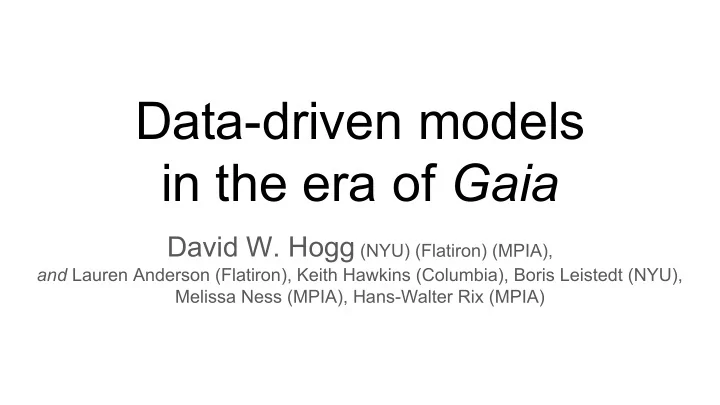

Data-driven models in the era of Gaia David W. Hogg (NYU) (Flatiron) (MPIA), and Lauren Anderson (Flatiron), Keith Hawkins (Columbia), Boris Leistedt (NYU), Melissa Ness (MPIA), Hans-Walter Rix (MPIA)
Thank you, Gaia ● Thank you for the early data release (DR1) and steady data releases. ● Impact will be huge (it already is). ● We recognize and appreciate how much work these early releases are. ○ (But can we also get trial data to, say, train new models? cf . Steinmetz)
Gaia Sprints ● Hack for one intense week on the project of your choosing. ● Enforced policy of openness. ● Already produced 12 refereed papers! ○ (including all Gaia results in this talk) ● Next one is the week of 2018 June 03 in New York City. ○ We will pay travel expenses for Gaia team members. ○ http://gaia.lol/
(my) Gaia Mission ● My vision: A precise parallax for every star of the billion ! ● But: Gaia parallaxes are only precise for nearby stars. ● But: Gaia delivers amazingly precise spectrophotometry.
(my) Gaia Mission ● Calibrate stellar models at close distances? ● Use those models for photometric parallaxes at all distances? ● But: I don’t trust the numerical simulations!
The astrometrist’s view of the world ● Geometry > Physics ● Physics > Numerical simulations of stars ○ (even spectroscopic radial velocity measurements are suspect !)
What can I contribute? ● You don’t have to use physics to build an accurate stellar model. ● Data > Numerical simulations of stars!
Statistical shrinkage ● If you observe a billion related objects, every object can contribute some kind of information to your beliefs about every other one.
Causal structure ● To capitalize on shrinkage, you must impose the causal structure in which you strongly believe. ● For example: Geometry & relativity. ● For example: Gaia noise model.
Graphical models
Anderson et al 2017 arXiv:1706.05055 ● Flexible mixture-of-Gaussian model for the noise-deconvolved color–magnitude diagram. ● Using Gaia TGAS parallax and 2MASS photometric noise (uncertainties) responsibly. ● Using rigid dust model (from Green et al ) . ● ...Then use the CMD model to get improved parallaxes .
Hawkins et al 2017 arXiv:1705.08988 ● How precise are red-clump stars as standard candles? ● Build a mixture model for RC stars and contaminants. ● Fit for mean and dispersion of RC absolute magnitudes, taking account of the TGAS and photometric uncertainties. ● ...Find 0.17 mag dispersion.
Hawkins et al 2017 arXiv:1705.08988
Leistedt et al 2017 arXiv:1703.08112 ● Similar to Anderson et al , but fully Bayesian. ● Model is less flexible, but it is tractable as a sampling problem. ● ...Now distance posteriors are fully marginalized with respect to CMD models!
So: Just throw machine learning at the problem? ● No! ○ missing data. ○ heteroskedasticity. ○ generalizability. ● Every good data-driven model will be bespoke .
Statistical shrinkage ● A data-driven model can be far more precise than the data on which it was trained. ● (But not more accurate .)
Statistical philosophy ● Pragmatism reigns. ○ Full Bayes ( eg, Leistedt et al ). ○ Maximum marginalized likelihood ( eg, Anderson et al ). ○ Maximum likelihood ( eg, Ness et al ). ● The important thing is the causal structure , not the statistical philosophy.
Ness et al 2017 arXiv:1701.07829 ● Use high-SNR APOGEE spectra as training set. ● Train The Cannon (Ness et al 2015) to get detailed chemical abundances. ● Apply to low-SNR APOGEE spectra. ● ...Find far more precise chemical homogeneity among cluster stars than in the training data. ○ (also: better results at lower SNR)
Aside: Proper motions are like parallaxes ● Proper motions decrease with distance like parallaxes. ● With a position–velocity model for the MW, they can be combined. ○ cf . Floor’s talk; cf . “reduced proper motion” ○ At large distances (and 10-year mission) we expect proper motions might dominate information.
Fundamental assumption of data-driven models ● Stationarity . ● ie: The causal structure is correct. ● ie: All non-trivial dependencies are represented in the graphical model.
Assumptions can be tested ● By construction, data-driven models are easy to validate. ● When the causal structure is insufficient, the failures appear in simple validations or visualizations.
Example: Halo stars are different from Disk stars ● Different distributions of metallicity -> different color–magnitude diagrams. ● Solution: Add kinematics and Galactocentric distance into the graphical model, and permit the model to discover this.
Summary ● There is no longer any reason to use numerical stellar models to generate photometric parallaxes. ● The billion-star catalog plus statistical shrinkage will deliver enormous precision (and accuracy), better than any physics models. ● Data > Numerical models of stars.
Recommend
More recommend